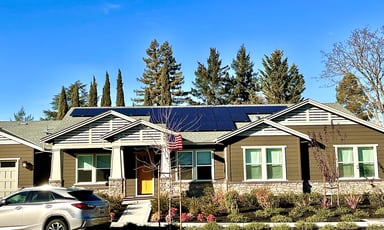“Stabilizing energy costs” and “hedging against inflation” are terms usually associated with business operations and finance. But they apply to your home, too.
With inflation and energy costs soaring, now is the perfect time to stabilize your home energy costs. It’s actually quite easy. Solar energy offers you lower-cost electricity at a predictable, stable price that is locked in for years.
When you go solar, you do more than lower your electric bills and help the planet. You also insulate your family from the skyrocketing energy costs affecting much of the world today.
Why Energy Costs are Rising
The most visible impact of inflation on Americans is at the gas pump. Escalating gasoline prices affect our household budgets immediately. But inflation is also driving up prices for other forms of energy, including electricity and home heating fuels like oil and natural gas.
Here are the three main reasons why energy prices are soaring, in the U.S. and worldwide:
- Pandemic-induced inflation
- The war in Ukraine, which impacts Russian energy exports
- Environmental catastrophes.
Let’s dig into each of those, and then we’ll explain how solar is an easy solution for these energy challenges.
Pandemic-Induced Inflation
A stable economy means stable prices. But the COVID-19 pandemic threw us into several years of instability. People stopped driving and flying, for business and for pleasure. Demand for some non-essential household goods dropped. At the same time, factories were often scaled back or shuttered due to pandemic lockdowns, and the global supply chain was thrown out of whack. Demand was fluctuating and hard to predict. Supply didn’t always meet demand. And prices went up as a result.
In the area of energy, supply chain issues affected production. For example, oil and gas suppliers reduced their output in accordance with the drop in demand.
Ironically, the return to a more normal life as the pandemic has come under control is also contributing to inflation. Suddenly, people are driving and flying in droves, and demand for consumer goods, including energy, has jumped up. When the available supply doesn’t meet the new level of demand, prices go up.
The War in Ukraine
Russia’s invasion of Ukraine has thrown global energy markets into turmoil. Why? Simply because Russia controls such a huge piece of the world’s energy supply, so any change or reduction in its supply can have a huge impact on global energy prices.
In this case, the commitment by many Western countries to stop or reduce their imports from Russia has cut Russia’s energy exports. That step was one of many economic sanctions designed to reduce the amount of money Russia has available to finance its war in Ukraine.

According to this NBC news report, Russia is by far the largest exporter for natural gas worldwide. And—this one might surprise you—it exports more crude oil than any country except Saudi Arabia.
Much of Europe has historically relied on Russian as a major energy source. Even the U.S. was importing a substantial amount of Russian oil before we imposed economic sanctions on Putin—8% of our oil and gas imports according to this article.
Experts suggest the Russia-Ukraine War has permanently re-shaped global energy markets. Russia remains an energy giant, but is now exporting more to China, India and Turkey than to Europe.
While the war continues, so will the sanctions most likely. The so-called “G7” group of industrialized economies—the U.S., the U.K., Canada, France, Germany, Italy, Japan and the European Union—agreed late last year to impose a price cap on Russian oil imports for those countries still importing Russian oil. (The U.S. and U.K. had already banned imports of Russian oil.)
How does all this impact Americans? According to the World Economic Forum, the war has almost doubled energy costs (electricity, home heating oil, etc.) for households worldwide. CNN reports that one year into the war (in February 2023), Americans are still feeling the pinch at the gas pump, although the impact has eased somewhat:
“US gas prices shot up $1.48 a gallon, or 42%, to a record $5.02 between the day before Russia’s invasion a year ago and the record price reached on June 14 [2023].”
The report estimates U.S. households spent $900 more on gasoline in 2022 than in 2021 as a result.
Environmental Catastrophes
Rising energy prices can also be tied to “natural disasters.” (We put the term in quotation marks because increasingly, weather-related catastrophes are being linked to climate change caused by our human activities, so there’s nothing “natural” about them.)
In an extreme case, think back to the February 2021 ice storm in Texas, which made national news for weeks. Cold temperatures and an ice storm took out much of the power grid, leaving millions without electricity and heat for days.

With the energy supply constrained, the electricity price per kilowatt-hour rose from $0.12 to an unheard of $9.00. Some customers—those who actually had power—received electric bills of $5,000!
Here in California, our bigger environmental challenge is wildfires. Not only do the fires result in power cuts, property damage and even loss of life; they also can contribute to higher energy prices. This is true of almost any natural disaster, from hurricane to mudslide.
Environmental disasters usually damage energy industry infrastructure, whether that’s the power lines that deliver electricity to the home, or the transportation network that delivers oil from a rig to a refinery. All that damage costs money to repair, and those costs are passed on to consumers.
Looking ahead
It’s hard to find a prediction for 2023 that suggests energy prices will come down. Recent financial reports and forecasts predict pandemic impacts will continue to reverberate throughout the economy, and inflation will continue, through 2023, although it won’t be as severe as it was in 2021 and 2022. Electricity prices are among those that will continue to be affected.
Global energy markets will remain in turmoil for some time, and that will trickle down to U.S. residential energy prices.
And the uncertainties and expenses related to climate-induced disasters are likely to get worse, not better.
Saved by Solar
Now for the upbeat part of this article!
Solar energy is an easy way to protect your family and your budget from energy price spikes and continued high prices.

The savings you get on solar are well-documented. Chances are, you have a friend or relative who brags about their low electric bills since installing panels on their roof.
While zeroing out your bill under California’s new net metering rules is harder to achieve, solar still provides solid paybacks and delivers strong monthly savings on your utility bill. And these savings increase if you pair battery storage with the solar.
But solar can save you from related ills as well. We said above that solar benefits include lower-cost electricity at a predictable, stable price, that is locked in for years. Here’s how that translates into benefits related to global energy prices:
Stabilize your energy costs – Wouldn’t it be great if the unit price of milk or natural gas or your child’s college tuition remained stable from year to year? Sadly, that’s unlikely to happen. But, with solar energy, your electricity price can be stable year to year. The amount of electricity you use varies by month. But the price you pay for each kilowatt-hour of your solar electricity can be determined for years at a time. And that price is significantly lower than the price you currently pay your utility company. This lower price will protect you against the instability and high costs of the energy market.
If you go solar with Citadel and finance the system with a solar loan, you pay the same amount every month, and you even have a say in what that amount is.
Hedge against rising energy costs – A hedge is an investment you make to reduce your exposure to something else. It protects you from swings in the pricing of a product or service. When you invest in a solar energy system for your home (which can be done with no money down), you protect your household from rising energy costs.
When’s the last time your utility lowered your electricity price? Can’t remember? That’s because it rarely, if ever, happens. Just this year, PG&E announced a 32% rate increase that will translate to bills around $80 higher per month.
Knowing that utility prices only go up, take the bull by the horns and go solar now to be protected from future rate hikes.
In summary, when you go solar, you do more than lower your electric bills and help the planet. You also stabilize your energy costs and insulate your family from the skyrocketing energy prices affecting much of the world today.
To learn more about solar, see our blog articles on:


